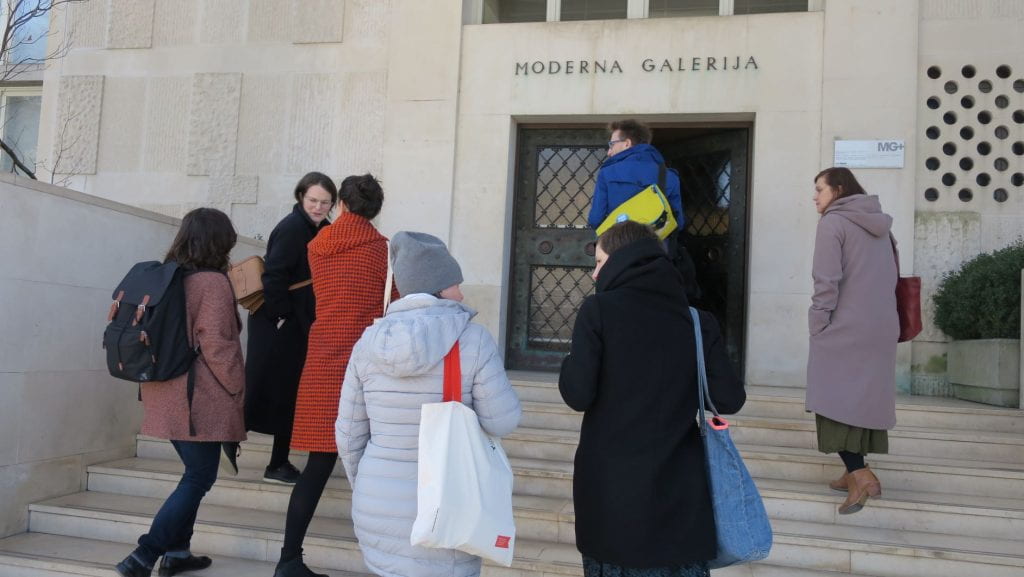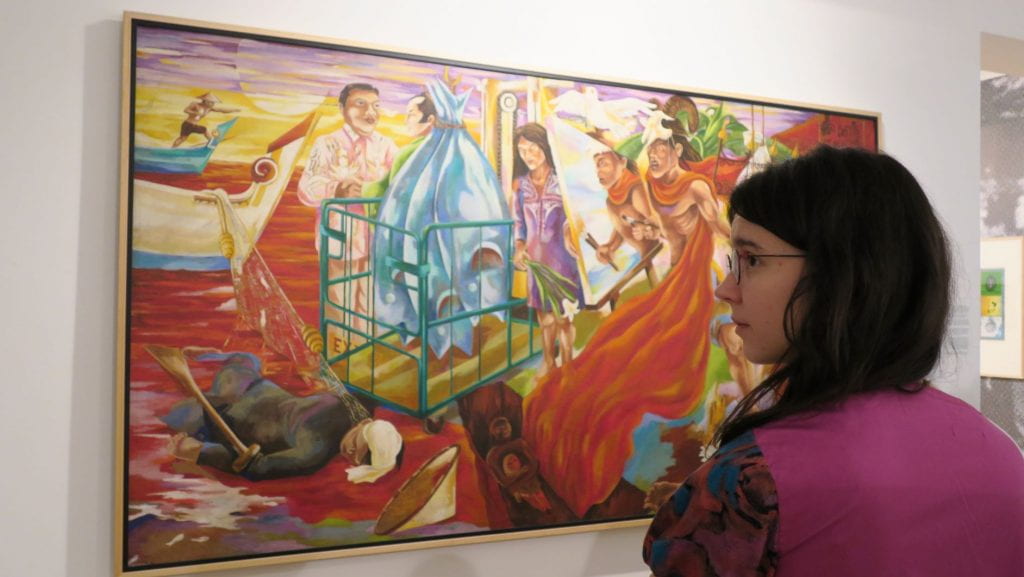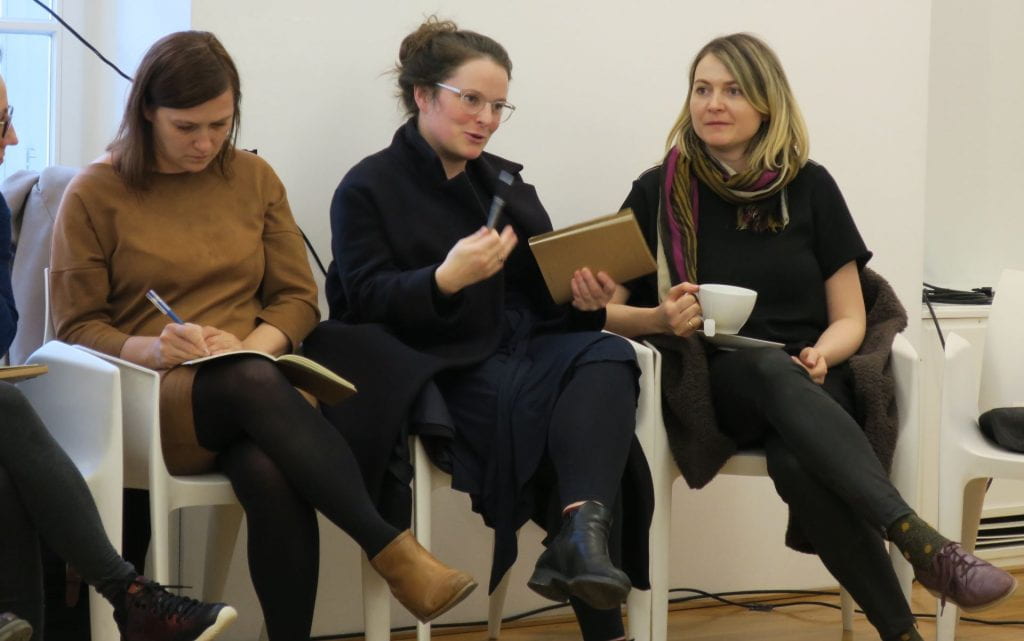Moderna galerija
By confrontations, on 29 April 2019
 As curator Marko Jenko explained, the permanent collection of Moderna galerija has a novel layout that gives the visitor the choice of either following the meandering path of a heterogenous local art history from the fin de siècle to the breakup of Yugoslavia, or taking a lateral short cut travelling straight from the modernist avant-garde of the 1920s through the Partisan art of the Second World War to the neo-avant-garde group OHO and Neue Slowenische Kunst in the 1980s.
As curator Marko Jenko explained, the permanent collection of Moderna galerija has a novel layout that gives the visitor the choice of either following the meandering path of a heterogenous local art history from the fin de siècle to the breakup of Yugoslavia, or taking a lateral short cut travelling straight from the modernist avant-garde of the 1920s through the Partisan art of the Second World War to the neo-avant-garde group OHO and Neue Slowenische Kunst in the 1980s.

 The focus of Confrontations meant that the group was just as interested in engaging with the less prominent styles and more problematic artistic phenomena from the Informel and Slovenian Dark Modernism to the eclectic painterly styles of the 1980s.
The focus of Confrontations meant that the group was just as interested in engaging with the less prominent styles and more problematic artistic phenomena from the Informel and Slovenian Dark Modernism to the eclectic painterly styles of the 1980s. The participants also found instructive the social, political and art-institutional chronology of Slovenian art in the central hall that poignantly ends with Slovenian independence in 1991.
The participants also found instructive the social, political and art-institutional chronology of Slovenian art in the central hall that poignantly ends with Slovenian independence in 1991.
(MRF)
Metelkova Group Seminar
By confrontations, on 29 April 2019
 After the insightful introduction to Slovenian art through the Modern galerija’s collection and a visit to the neighbouring International Centre of Graphic Art, which through its long-running biennial conveyed the intricacies of exhibition diplomacy in non-aligned Yugoslavia, the group headed to the Museum of Contemporary Art Metelkova (MSUM). The Confrontations seminars continued in a comparative spirit by examining the specificities of Croatian and Slovenian views of Yugoslav art history, as well as expanding the discussion further. Constanze Fritzsch spoke about Socialist Realism: A sublation of art into life as an abstract painter like Hermann Glöckner would have understood it?, complicating the established narratives of the distinctions between socialist realism and abstract art. Daniel Véri spoke about Conflicting Narratives: The Memory of the Holocaust in 1960s Hungarian Art, distinguishing between the restrictive format of official monumental commemorations and the more testing approaches to Holocaust memory in the work of experimental artists.
After the insightful introduction to Slovenian art through the Modern galerija’s collection and a visit to the neighbouring International Centre of Graphic Art, which through its long-running biennial conveyed the intricacies of exhibition diplomacy in non-aligned Yugoslavia, the group headed to the Museum of Contemporary Art Metelkova (MSUM). The Confrontations seminars continued in a comparative spirit by examining the specificities of Croatian and Slovenian views of Yugoslav art history, as well as expanding the discussion further. Constanze Fritzsch spoke about Socialist Realism: A sublation of art into life as an abstract painter like Hermann Glöckner would have understood it?, complicating the established narratives of the distinctions between socialist realism and abstract art. Daniel Véri spoke about Conflicting Narratives: The Memory of the Holocaust in 1960s Hungarian Art, distinguishing between the restrictive format of official monumental commemorations and the more testing approaches to Holocaust memory in the work of experimental artists.

(MRF)
Utopian and Dystopian 1980s
By confrontations, on 29 April 2019
 A seminar with Marina Gržinić and Jovita Pristovšek offered a compelling interpretation of the development of the Slovenian artistic scene during the 1980s, as well as introducing the Confrontations participants to the microhistory of the Metelkova site and the complex relationship of the museum to local social movements. Gržinić shared some of her own memories and experiences of the eventful 1980s, emphasising the role of Škuc gallery in giving a platform to alternative currents and the sub-cultural challenge to the heteronormative values of both socialism and capitalism in the period, noting that, ‘if post-modernism was political anywhere, it was under socialism.’
A seminar with Marina Gržinić and Jovita Pristovšek offered a compelling interpretation of the development of the Slovenian artistic scene during the 1980s, as well as introducing the Confrontations participants to the microhistory of the Metelkova site and the complex relationship of the museum to local social movements. Gržinić shared some of her own memories and experiences of the eventful 1980s, emphasising the role of Škuc gallery in giving a platform to alternative currents and the sub-cultural challenge to the heteronormative values of both socialism and capitalism in the period, noting that, ‘if post-modernism was political anywhere, it was under socialism.’
(MRF)
Southern Constellations
By Tomasz Załuski, on 29 April 2019
 During our stay in Ljubljana we visited the exhibition Southern Constallations at Moderna galerija – Museum of Contemporary Art Metelkova. This impressive show, curated by Bojana Piškur and based on her long-term research, presented the role of arts, cultural collaboration, exchange and diplomacy in the history of the Non-Aligned Movement. The movement was a political initiative, founded officially in the early 1960s, in which countries belonging to neither of the two Cold War blocks were involved. They were mainly Third World African and Asian countries but also Yugoslavia which pursued its “third way”. And it was from the perspective of Yugoslavia, quite obviously, as one of the non-aligned countries which had initiated the movement, that the exhibition approached the whole issue. The show combined historical documentation of different cultural exchanges and initiatives within the network of the non-aligned countries, along with some artworks from between the early 1960s and the late 1980s, and contemporary artists interventions.
During our stay in Ljubljana we visited the exhibition Southern Constallations at Moderna galerija – Museum of Contemporary Art Metelkova. This impressive show, curated by Bojana Piškur and based on her long-term research, presented the role of arts, cultural collaboration, exchange and diplomacy in the history of the Non-Aligned Movement. The movement was a political initiative, founded officially in the early 1960s, in which countries belonging to neither of the two Cold War blocks were involved. They were mainly Third World African and Asian countries but also Yugoslavia which pursued its “third way”. And it was from the perspective of Yugoslavia, quite obviously, as one of the non-aligned countries which had initiated the movement, that the exhibition approached the whole issue. The show combined historical documentation of different cultural exchanges and initiatives within the network of the non-aligned countries, along with some artworks from between the early 1960s and the late 1980s, and contemporary artists interventions.
For me, given the context of our Confrontations project and the issues we were dealing with during our visit to Zagreb and – especially – to Ljubljana, Southern Constellation really pinpointed the question of East European art history. It is significant that Moderna galerija, which has been playing an important role in the formation and development of studies on East European art of the second half of the XXth century (e.g. the exhibitions Body and the East, 1998; Interrupted Histories, 2006), seems now to be taking a different direction and trying to rediscover Yugoslavia’s participation in a global but at the same time non-Western network. I quess that one of the agendas behind looking for such a forgotten, “interrupted” history of another globality is to position one’s own local art production within the narrative of global art history on one’s own terms: to stress one’s specificity and difference with regard to Western globalisation by showing one’s connections to the “Third World”, “postcolonial”, “(semi)peripheral”, “Global South” etc. networks, but also, by the same token, to avoid the reduction of all Europe to Western Europe, not so uncommon in postcolonial studies. 
 In this sense, the exhibition staged what seems to be a need for reinventing East European art history studies, especially ones that deal with the socialist period. Obviously, this need is not new, it has been with us for some time but it poses a task that is far from complete and yet to perform. It is a task of writing a history that still aims at establishing the specificity of a given local – national or regional – East European art phenomenon but shows it in its actual translocal connectedness, or transnational interdependency, not only within the Eastern bloc and across the West/East divide but also within other global networks next to it or beyond it. This can be, of course, applied not only to the art of Yugoslavia but also to that of other East European countries as well. After all, despite its participation in the Non-Aligned Movement, Yugoslavia was no exception here.
In this sense, the exhibition staged what seems to be a need for reinventing East European art history studies, especially ones that deal with the socialist period. Obviously, this need is not new, it has been with us for some time but it poses a task that is far from complete and yet to perform. It is a task of writing a history that still aims at establishing the specificity of a given local – national or regional – East European art phenomenon but shows it in its actual translocal connectedness, or transnational interdependency, not only within the Eastern bloc and across the West/East divide but also within other global networks next to it or beyond it. This can be, of course, applied not only to the art of Yugoslavia but also to that of other East European countries as well. After all, despite its participation in the Non-Aligned Movement, Yugoslavia was no exception here.
(Tomasz Załuski)
MSUM+
By confrontations, on 29 April 2019
 Moderna galerija director Zdenka Badovinac gave a first hand account of the institutional history of a museum that was instrumental in shaping the course of East European art history during the first post-communist decades, through exhibitions such as Body and the East and the founding of regionally-focussed Arteast 2000+ Collection. Curator Igor Španjol specifically introduced the series of four exhibitions revisiting the art of the 1980s that were recently staged by the museum.
Moderna galerija director Zdenka Badovinac gave a first hand account of the institutional history of a museum that was instrumental in shaping the course of East European art history during the first post-communist decades, through exhibitions such as Body and the East and the founding of regionally-focussed Arteast 2000+ Collection. Curator Igor Španjol specifically introduced the series of four exhibitions revisiting the art of the 1980s that were recently staged by the museum.
 Our final afternoon at MSUM+ also included a guest lecture by art historian Beti Žerovc, who generously shared insights into the importance of various deep historical, geopolitical and distinctly local factors in the course taken by Slovenian art, embedded at the crossroads of German-speaking and Slavic cultures.
Our final afternoon at MSUM+ also included a guest lecture by art historian Beti Žerovc, who generously shared insights into the importance of various deep historical, geopolitical and distinctly local factors in the course taken by Slovenian art, embedded at the crossroads of German-speaking and Slavic cultures. 


 We came together in a circle to evaluate the events and collective experience of the first Confrontations sessions in Zagreb and Ljubljana.
We came together in a circle to evaluate the events and collective experience of the first Confrontations sessions in Zagreb and Ljubljana.
(MRF)
IRWIN Studio
By confrontations, on 29 April 2019
 On our final evening we had the opportunity to meet Dušan Mandić, Miran Mohar, Borut Vogelnik and Andrej Savski from IRWIN, and to quiz them about the origins of the group, their experiences with the Slovenian and international art scene during the 1980s, as well as their current practice and perspectives on contemporary political and social challenges. It was fascinating to hear their views on the circulation of artistic movements in the Yugoslav cultural space of the early 1980s, the role of class origin and privileges in the supposedly egalitarian social structure of communist Yugoslavia, as well as their explanation of the relationship between Laibach, IRWIN and NSK as overlapping but independent entities. During our time in Ljubljana we saw IRWIN artworks prominently exhibited in the permanent collection of museums, heard curatorial and art historical presentations contextualising their practice within the cultural upheaval of the Yugoslav 1980s and even got to experience the generosity, humour and warm glow of a long-lived artist group that does not shy away from critically intervening in the construction of East European art historical narratives.
On our final evening we had the opportunity to meet Dušan Mandić, Miran Mohar, Borut Vogelnik and Andrej Savski from IRWIN, and to quiz them about the origins of the group, their experiences with the Slovenian and international art scene during the 1980s, as well as their current practice and perspectives on contemporary political and social challenges. It was fascinating to hear their views on the circulation of artistic movements in the Yugoslav cultural space of the early 1980s, the role of class origin and privileges in the supposedly egalitarian social structure of communist Yugoslavia, as well as their explanation of the relationship between Laibach, IRWIN and NSK as overlapping but independent entities. During our time in Ljubljana we saw IRWIN artworks prominently exhibited in the permanent collection of museums, heard curatorial and art historical presentations contextualising their practice within the cultural upheaval of the Yugoslav 1980s and even got to experience the generosity, humour and warm glow of a long-lived artist group that does not shy away from critically intervening in the construction of East European art historical narratives. 
(MRF)
 Close
Close



